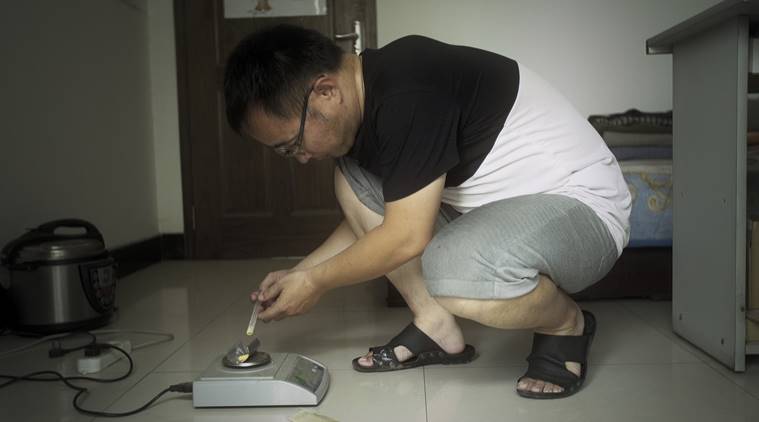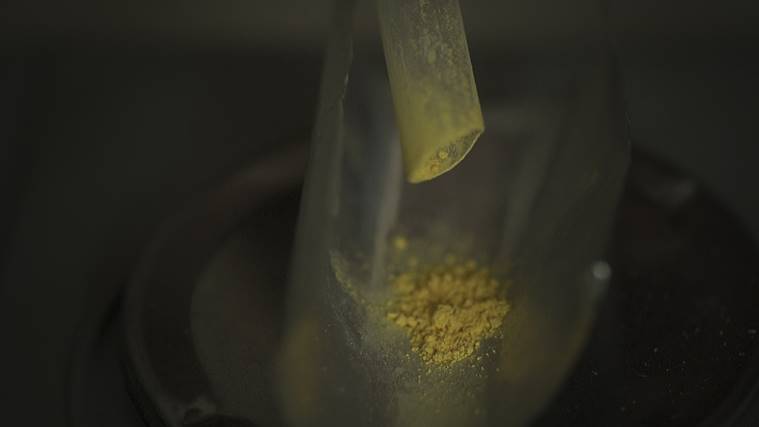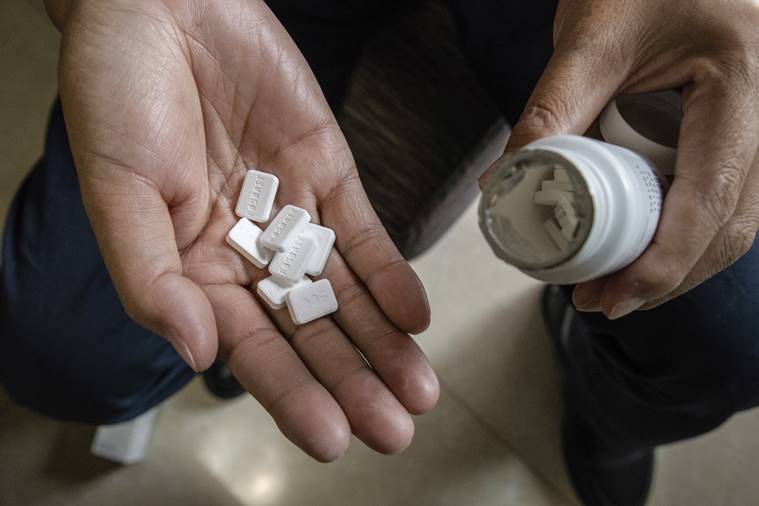In China, the desperate make medicine at home
China’s aging population is increasingly stricken with deadly diseases like cancer and diabetes, but many cannot find or afford drugs.

While China has achieved near-universal health insurance, the coverage is shallow. Patients must pay about 30 percent of costs out of pocket, compared with an average of about 10 percent in the United States. Many drugs are not covered. (Photo: New York Times)
Zhang Zhejun used a fat plastic straw to gently tap the pale yellow pharmaceutical powder onto a piece of silver foil that lay on an electronic scale. He made sure the amount was just right before he poured it into a clear capsule.
When making cancer drugs at home, the measurements must be precise.
Zhang had no medical experience and no background in making drugs professionally. He did this out of desperation. His mother suffered from lung cancer and required expensive drugs that China’s ambitious but troubled health care system couldn’t provide.
He was aware of the risks. The drug he was making had not been approved by regulators in China or the United States. Zhang had bought the raw ingredients online, but he was not sure from whom, or whether they were even real.
“We’re not picky. We don’t have the right to choose,” he said. “You just hope the sellers have a conscience.”
It is a desperation born of necessity. China’s aging population is increasingly stricken with deadly diseases like cancer and diabetes, but many cannot find or afford drugs.
The country’s rudimentary insurance system does not begin to cover the ever-rising prices of treatments and drugs. Coverage also depends on where somebody lives, and some rural residents still lack access to certain drugs.
Despite a costly new safety net from the government, illness remains the leading reason Chinese families fall below the poverty line, according to official figures.
Many of China’s problems are self-inflicted. Major bureaucratic hurdles keep lifesaving drugs out of the reach of millions who need them. Drug approvals, while accelerating, remain dauntingly backlogged. Until October last year, pharmaceuticals approved in the United States and Europe had to go through an extensive vetting process in China. Even now, foreign-made drugs have to clear another hurdle before insurance companies will pay for them.
To stay alive, many sick people in China — and the people who love them — break the law. Online marketplaces are filled with illegal pharmaceuticals. Dealers run underground pharmacies. In some cases, cancer patients and their families make the drugs themselves, finding the ingredients and the instructions online.
China’s challenges are playing out globally. Many of the same problems have pit world leaders, including President Donald Trump, against big pharmaceutical companies. The companies complain about regulatory hurdles and approval delays. High drug prices have roiled trade talks.
Lower prices send Americans to Canada and Mexico looking for the medicines they need. Patients from Russia to Britain desperately hunt for drugs through online “buyers’ clubs” — networks that scour the world for cheaper generic medicines.
In China, the public has become increasingly concerned about access to drugs, putting pressure on the leadership. This summer’s box-office hit “Dying to Survive” was based on the real-life story of a Chinese leukemia patient who ran a buyers’ club, smuggling generic drugs from India to save himself and others. It was almost universally lauded for shedding light on the difficulties of getting cancer drugs in China.
The movie’s popularity prompted Premier Li Keqiang to call for speeding up price cuts for the medication. China’s growing affluence has led to greater expectations among its people. The Communist Party’s grip on power depends heavily on providing improved opportunities for the public, including better health care.
“I don’t know whether they can do that,” said Zhou Jun, executive director of the U.S.-China Healthcare Cooperation Program in Beijing, a group that fosters closer working relations between the countries. “It’s going to be a challenge.” (Zhou died of cancer several months after speaking to The New York Times.)
Cost of Living
Last year, police raided Hong Ruping’s modest apartment in southwestern China. Under a television, they found what they were looking for: medicine to treat chronic kidney disease.
Hong, who is unemployed and has kidney dialysis three times a week, explained that the drugs — cheap knockoffs of Western pharmaceuticals from India — were for him.
The officers seized the drugs, warning that they were not approved by the country’s regulators. Then, the officers let him go.
After the raid, Hong continued to receive drugs in monthly packages — and they were not all for him. Hong is known in China as a drug “daigou,” or “purchasing agent,” who procures pharmaceuticals through dubious means for people who cannot afford them or do not have access to them.
While many Chinese use daigou to buy edible birds’ nests and South Korean facial masks made of snail slime, or infant formula from Australia, others rely on people like Hong to stay alive.
“I have this disease, and if they want to convict me, there’s nothing I can do,” Hong said. “What is the difference between going to jail and being sick? There is no freedom.”
While China has achieved near-universal health insurance, the coverage is shallow. Patients must pay about 30 percent of costs out of pocket, compared with an average of about 10 percent in the United States. Many drugs are not covered.
The paltry coverage exposes hundreds of millions of Chinese to sharply rising costs. In the first three quarters of last year, China’s health care expenditure per capita rose 13.2 percent, compared with a 9.1 percent increase in disposable income per capita, according to government data.
That leads many Chinese to smuggling, especially from India, where prices of many drugs are capped. In China, the drug that Hong needed cost just over $4,200 a year, 10 times the price in India.
Some health experts are torn about encouraging the use of drugs that are not approved. “I find it hard to give a one-size-fits-all view on whether they should or shouldn’t do it,” said Gordon Liu, director of Peking University’s China Center for Health Economic Research and an adviser to the government.
“Some generics from India are likely to offer newer treatments than the existing medicines in the mainland,” Liu said. He added: “You’re acquiring drugs through informal channels. Not only are you taking on economic risks, but also the uncertainty of the technology.”
Dr. Shen Lin, director of digestive oncology at the Peking University Cancer Hospital, said several of her patients on long-term medication could not afford the drugs anymore, and had asked whether they could use generics from India. She has tried to dissuade them, saying she could not vouch for drugs from unofficial sources.
Still, she said, “if they continue on their path, they would go bankrupt.”
Making the List
To survive, many Chinese need foreign-made drugs. But they can be costly, when they are available at all.
First, drugs need to be approved. From 2001 to 2016, China approved just over 100 new drugs, about one-third the number in developed countries, according to the China Food and Drug Administration. Drugs could take six to seven years to get the green light, turning cancer for many into a death sentence.
Late last year, Chinese authorities said they would begin allowing drug companies to submit data from foreign clinical trials, along with other steps to speed up reviews. Approval times have dropped to two to three years. China has thinned its backlog of new drugs waiting for approval to 4,000 from 22,000 in 2017. The government is also pushing to develop more innovative, less costly pharmaceuticals to combat life-threatening diseases.
Still, the agency remains short staffed. China had roughly 600 reviewers at the end of 2016, compared with thousands in the United States.
Once approved, the drugs have to qualify for coverage under one of China’s insurance plans. That means earning a spot on the National Reimbursement Drug List — and that can take years. Beijing added 36 drugs to the list in 2017 and 17 this year. The last update was in 2009.
When the drugs do arrive, many Chinese patients, like Yao Xianghua, cannot afford them, even if they have government coverage.
A petite former elementary schoolteacher with blunt bangs, Yao had lung cancer that did not respond to surgery or a form of treatment called biotherapy. She was 68 in 2011, when the cancer was first diagnosed, and she felt she was too old to undergo chemotherapy and radiation.
“I give up,” she told her son, Zhang Zhejun. “I’m resigned to my fate.”
Her doctor prescribed Iressa, a drug made by AstraZeneca that keeps cancer cells from multiplying. The drug had been added to the reimbursement drug list after AstraZeneca agreed to halve the price to just under $1,000 a month.
It was still too expensive. Yao was covered by China’s “rural cooperative medical scheme,” which provides only modest benefits compared with the insurance for urban residents. She received a monthly pension of $460. Her son said the rural scheme at that time did not pay for imported drugs.
Zhang vowed to save her. He quit a decent-paying job and moved in with his parents in a barely furnished apartment in Jinzhou, a largely industrial and heavily polluted city.
Zhang discovered that India made a cheaper, generic version of Iressa. It worked for a while. But Yao developed a resistance to it after about nine months. Zhang needed alternatives.
He went online.
Do-It-Yourself Medication
China in recent years has become the world’s largest home of internet users. Many Chinese now shop almost exclusively in internet bazaars that offer everything from groceries and hot meals to jewelry and cars.
They can also buy pharmaceuticals — even the raw ingredients to illegally make drugs themselves.
Many start on forums devoted to patients and their loved ones when they cannot get answers anymore. The two most popular are “I Want Miracles,” which is dedicated to helping people with lung cancer, and “Dances With Cancer.” The forums combined have just over 440,000 members.
“This is the current state of health care in China,” said Chen Yun, who runs “I Want Miracles.” “Every doctor is just too busy, and there’s no way that they can explain many things to you clearly. But if you want to figure it out, you just have to learn by yourself.”
In many ways, they resemble medical websites in other countries. Then there are the posts on how to make drugs yourself. They direct at-home drugmakers to buy the ingredients online, on marketplaces run by Alibaba Group, the e-commerce giant, and elsewhere. Dozens of suppliers offer free samples and promise fast delivery.
“Our products’ quality better than the standard quality in the market,” advertised Xian Health Biochem Technology, which was selling the ingredients for vandetanib, a cancer drug.
Sellers mail the ingredients out in envelopes or, for those with bigger orders, in drums.
Alibaba abides by local laws and has “rules and systems in place” that help it identify listings that infringe on its policies, a spokeswoman said in an email.
Desperate to help his mother, Zhang did a basic search: “What to do after patient develops drug resistance on Iressa?” He happened upon “Dances With Cancer” and an active participant and a longtime cancer patient called “Bean Spirit,” who wrote a manual on how to make drugs at home.
Zhang, who previously worked at a pharmaceutical factory but was not involved in making drugs, started on his own version. He bought the ingredients for AstraZeneca’s Tagrisso, a lung cancer drug. He spent just over $150 for a month’s worth of ingredients, plastic capsules and an electronic scale.
“The raw ingredients are worth more than the price of gold,” he said.
When the drugs stopped working for his mother, Zhang began making others. He started having sleepless nights, worried that he would not be able to find the ingredients each time a drug stopped working.
“You don’t know whether the thing that’s ahead of you is a pit or a road,” he said, wiping tears off his face. “But you must go forward. You can’t stop.”
In July 2017, Zhang started making WZ4002, yet another drug. It was discovered in 2005 by the Dana-Farber Cancer Institute in Boston but has not been approved by regulators in the United States or China.
His mother told Zhang that it caused dizzy spells. Earlier, she had come down with a severe bout of diarrhea after taking one of the homemade drugs and had to be hospitalized for a month.
Both mother and son shrugged off any side effects.
“How do you feel after taking the new medicine?” Zhang asked his mother.
“Well, I think it feels a little bit less painful now,” Yao said.
“Less painful?” he asked.
“Remember, I told you that sometimes this part and this and this part hurt,” she told him. “Now these parts are less painful.”
* Yao died in October 2017, two years after Zhang started making drugs for her. The cause of death was gastrointestinal bleeding and acute bronchitis. Zhang said it was unclear whether the drugs that he had made were the cause.
 To stay alive, many sick people in China — and the people who love them — break the law. Online marketplaces are filled with illegal pharmaceuticals. (Photo: New York Times)
To stay alive, many sick people in China — and the people who love them — break the law. Online marketplaces are filled with illegal pharmaceuticals. (Photo: New York Times) While China has achieved near-universal health insurance, the coverage is shallow. Patients must pay about 30 percent of costs out of pocket, compared with an average of about 10 percent in the United States. Many drugs are not covered. (Photo: New York Times)
While China has achieved near-universal health insurance, the coverage is shallow. Patients must pay about 30 percent of costs out of pocket, compared with an average of about 10 percent in the United States. Many drugs are not covered. (Photo: New York Times)





































No hay comentarios:
Publicar un comentario